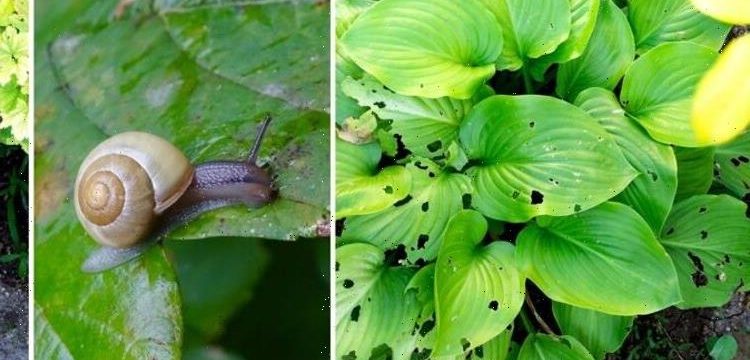Gardening expert demonstrates how to get rid of weeds
We use your sign-up to provide content in ways you’ve consented to and to improve our understanding of you. This may include adverts from us and 3rd parties based on our understanding. You can unsubscribe at any time. More info
Warmer weather, combined with damp conditions greatly increases the activity of slugs and snails. This means spring is the crucial time to protect the garden, especially if gardeners have any young seedlings. Luckily, there are lots of methods to help get rid of slugs and “deter” them.
Slugs and snails can cause a number of problems in the garden including eating holes in leaves, stems, flowers, tubers and bulbs.
Samantha Jones, gardening expert at MyJobQuote, recommended using broken eggshells to keep them at bay.
She told Express.co.uk: “Slugs and snails struggle on jagged surfaces, so broken eggshells are ideal for slowing their progress.
“Shop bought pest solutions such as copper tape can have some effect.

“However, it won’t stop them completely, so you’ve got a few options.”
Slugs and snails love leafy plants and vegetables so the expert recommended growing and keeping these off the ground.
This includes cucumbers, tomatoes and lettuce leaves.
Plants including dahlias, sweet peas and tulips are regularly attacked by slugs and it can be difficult to grow these plants if gardeners have a big slug problem.
DON’T MISS:
How to ‘enhance desirability’ when selling and increase ‘market value’ [EXPERT]
Common security mistakes Britons make when protecting their homes [INSIGHT]
Mrs Hinch fan shares £1 trick to remove bathroom radiator rust [EXPLAINER]
Snails can damage fruit trees and eat any decomposing organic matter including rotting leaves.
Samatha added: “Or position them in-between plants with strong smelling foliage such as lavender and curry plants to deter them.
“Leave a few dandelions to grow, to tempt them away from your prize plants.
“If you’re a night owl, then go out with a torch and remove them while they’re out in the open.

“Or put feeders near your borders to encourage birds to do the hard work for you.”
This is because most slugs feed at night and leave slime trails.
For those who think they may have a slug infestation, what are the symptoms?
The Royal Horticultural Society (RHS) explained: “Slugs sometimes leave behind slime trails, which can be seen as a silvery deposit on hard surfaces, leaves and stems.

“Slugs can make irregular holes in plant tissue with their rasping mouthparts.
“They can kill young seedlings by completely eating them.
“Long-keeled slugs of the Milaciade family live underground and tunnel into potato tubers and bulbs.
“In some gardens these slugs can damage a large proportion of the tubers of main crop potatoes, damage is similar to that of wireworms.”
Source: Read Full Article
